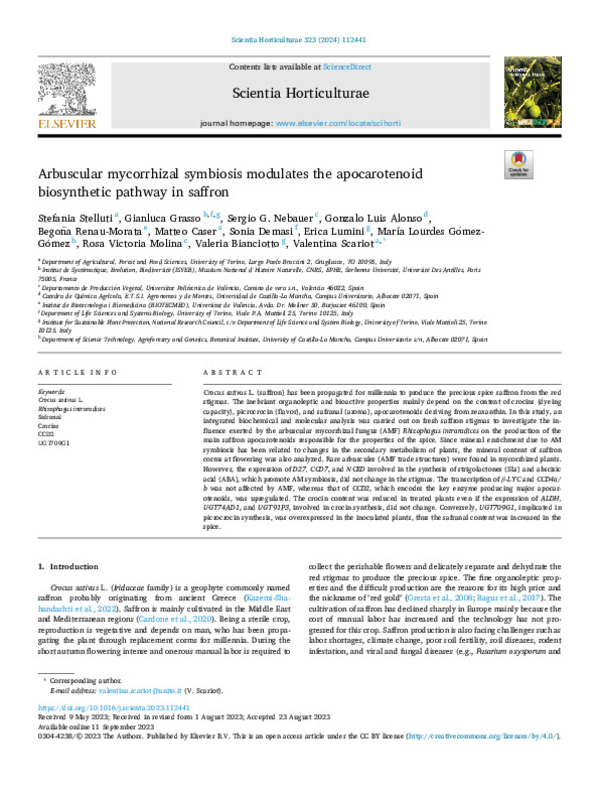JavaScript is disabled for your browser. Some features of this site may not work without it.
Buscar en RiuNet
Listar
Mi cuenta
Estadísticas
Ayuda RiuNet
Admin. UPV
Arbuscular mycorrhizal symbiosis modulates the apocarotenoid biosynthetic pathway in saffron
Mostrar el registro sencillo del ítem
Ficheros en el ítem
| dc.contributor.author | Stelluti, Stefania
|
es_ES |
| dc.contributor.author | Grasso, Gianluca
|
es_ES |
| dc.contributor.author | Nebauer, Sergio G.
|
es_ES |
| dc.contributor.author | Alonso, Gonzalo Luis
|
es_ES |
| dc.contributor.author | Renau-Morata, Begoña
|
es_ES |
| dc.contributor.author | Caser, Matteo
|
es_ES |
| dc.contributor.author | Demasi, Sonia
|
es_ES |
| dc.contributor.author | Lumini, Erica
|
es_ES |
| dc.contributor.author | Gómez-Gómez, Maria Lourdes
|
es_ES |
| dc.contributor.author | Molina, Rosa Victoria
|
es_ES |
| dc.contributor.author | Bianciotto, Valeria
|
es_ES |
| dc.contributor.author | Scariot, Valentina
|
es_ES |
| dc.date.accessioned | 2024-04-11T07:56:26Z | |
| dc.date.available | 2024-04-11T07:56:26Z | |
| dc.date.issued | 2024-01-01 | es_ES |
| dc.identifier.issn | 0304-4238 | es_ES |
| dc.identifier.uri | http://hdl.handle.net/10251/203333 | |
| dc.description.abstract | [EN] Crocus sativus L. (saffron) has been propagated for millennia to produce the precious spice saffron from the red stigmas. The inebriant organoleptic and bioactive properties mainly depend on the content of crocins (dyeing capacity), picrocrocin (flavor), and safranal (aroma), apocarotenoids deriving from zeaxanthin. In this study, an integrated biochemical and molecular analysis was carried out on fresh saffron stigmas to investigate the in-fluence exerted by the arbuscular mycorrhizal fungus (AMF) Rhizophagus intraradices on the production of the main saffron apocarotenoids responsible for the properties of the spice. Since mineral enrichment due to AM symbiosis has been related to changes in the secondary metabolism of plants, the mineral content of saffron corms at flowering was also analyzed. Rare arbuscules (AMF trade structures) were found in mycorrhized plants. However, the expression of D27, CCD7, and NCED involved in the synthesis of strigolactones (SLs) and abscisic acid (ABA), which promote AM symbiosis, did not change in the stigmas. The transcription of beta-LYC and CCD4a/ b was not affected by AMF, whereas that of CCD2, which encodes the key enzyme producing major apocar-otenoids, was upregulated. The crocin content was reduced in treated plants even if the expression of ALDH, UGT74AD1, and UGT91P3, involved in crocin synthesis, did not change. Conversely, UGT709G1, implicated in picrocrocin synthesis, was overexpressed in the inoculated plants, thus the safranal content was increased in the spice. | es_ES |
| dc.description.sponsorship | This research was funded by the program Interreg V-A Francia Italia Alcotra (Grant No. 1139 "ANTEA - Attivita innovative per lo sviluppo della filiera transfrontaliera del fiore edule"; and grant no. 8336 "ANTES-Fiori eduli e piante aromatiche: attivita capitalizzazione dei progetti ANTEA ed ESSICA"). | es_ES |
| dc.language | Inglés | es_ES |
| dc.publisher | Elsevier | es_ES |
| dc.relation.ispartof | Scientia Horticulturae | es_ES |
| dc.rights | Reconocimiento (by) | es_ES |
| dc.subject | Crocus sativus L. | es_ES |
| dc.subject | Rhizophagus intraradices | es_ES |
| dc.subject | Safranal | es_ES |
| dc.subject | Crocins | es_ES |
| dc.subject | CCD2 | es_ES |
| dc.title | Arbuscular mycorrhizal symbiosis modulates the apocarotenoid biosynthetic pathway in saffron | es_ES |
| dc.type | Artículo | es_ES |
| dc.identifier.doi | 10.1016/j.scienta.2023.112441 | es_ES |
| dc.relation.projectID | info:eu-repo/grantAgreement/Interreg//1139//ANTEA , Attività innovative per lo sviluppo della filiera transfrontaliera del fiore edule/ | es_ES |
| dc.relation.projectID | info:eu-repo/grantAgreement/Interreg//8336//ANTES, Fiori eduli e piante aromatiche: attivita ` capitalizzazione dei progetti ANTEA ed ESSICA/ | es_ES |
| dc.rights.accessRights | Abierto | es_ES |
| dc.description.bibliographicCitation | Stelluti, S.; Grasso, G.; Nebauer, SG.; Alonso, GL.; Renau-Morata, B.; Caser, M.; Demasi, S.... (2024). Arbuscular mycorrhizal symbiosis modulates the apocarotenoid biosynthetic pathway in saffron. Scientia Horticulturae. 323. https://doi.org/10.1016/j.scienta.2023.112441 | es_ES |
| dc.description.accrualMethod | S | es_ES |
| dc.relation.publisherversion | https://doi.org/10.1016/j.scienta.2023.112441 | es_ES |
| dc.type.version | info:eu-repo/semantics/publishedVersion | es_ES |
| dc.description.volume | 323 | es_ES |
| dc.relation.pasarela | S\509252 | es_ES |
| dc.contributor.funder | Interreg | es_ES |








